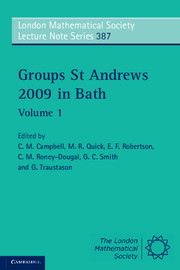Book contents
- Frontmatter
- Contents
- Introduction
- A speech in honour of John Cannon and Derek Holt
- Finite groups of Lie type and their representations
- Iterated monodromy groups
- Engel elements in groups
- Some classes of finite semigroups with kite-like egg-boxes of D-classes
- Structure of finite groups having few conjugacy class sizes
- Group theory in cryptography
- A survey of recent results in groups and orderings: word problems, embeddings and amalgamations
- A survey on the minimum genus and maximum order problems for bordered Klein surfaces
- On one-relator quotients of the modular group
- Miscellaneous results on supersolvable groups
- Automorphisms of products of finite groups
- A rational property of the irreducible characters of a finite group
- Automotives
- On n-abelian groups and their generalizations
- Computing with matrix groups over infinite fields
- Trends in infinite dimensional linear groups
- Engel conditions on orderable groups and in combinatorial problems (a survey)
A speech in honour of John Cannon and Derek Holt
Published online by Cambridge University Press: 05 July 2011
- Frontmatter
- Contents
- Introduction
- A speech in honour of John Cannon and Derek Holt
- Finite groups of Lie type and their representations
- Iterated monodromy groups
- Engel elements in groups
- Some classes of finite semigroups with kite-like egg-boxes of D-classes
- Structure of finite groups having few conjugacy class sizes
- Group theory in cryptography
- A survey of recent results in groups and orderings: word problems, embeddings and amalgamations
- A survey on the minimum genus and maximum order problems for bordered Klein surfaces
- On one-relator quotients of the modular group
- Miscellaneous results on supersolvable groups
- Automorphisms of products of finite groups
- A rational property of the irreducible characters of a finite group
- Automotives
- On n-abelian groups and their generalizations
- Computing with matrix groups over infinite fields
- Trends in infinite dimensional linear groups
- Engel conditions on orderable groups and in combinatorial problems (a survey)
Summary
Ladies and Gentlemen, Mathematicians and friends. I find myself the ass on whose back has been laid the burden of expressing our feelings on the birthday celebrations of Derek and John. It is a matter of regret that John cannot be with us, but I shall follow the famous and ill-written paper by Ella Wheeler Wilcox, and turn my mind to the happier aspects of this occasion. As we walk around the Cayley diagram of life, we are constantly at cross-roads; but a birthday is an Irish roundabout where there are but two exits: we can look forward, or we can look back.
Looking back, my first introduction to programming was re-writing the STACK-HANDLER for John's CAYLEY program to work on the Queen Mary College mainframe machine. This, of course, was written in FORTRAN; and the success of the translation owed much to expert supervision. The first time I proved a theorem as the result of computer-generated information this information was obtained using CAYLEY, on a mainframe at the ETH in Zurich, using punched cards.
At about the same time (plus or minus 10 years) Derek and I overlapped in a certain Lehrstuhl in Aachen, and I was told, in hushed tones, that this Englishman was writing a program in C to calculate cohomology groups. The combination of the two C words, namely C and cohomology, induced a feeling of awe that was akin to the feelings of builders of propeller-drive fighter aircraft towards the end of the late war towards colleagues at the other end of the shed who were building the first jets.
- Type
- Chapter
- Information
- Groups St Andrews 2009 in Bath , pp. xi - xiiiPublisher: Cambridge University PressPrint publication year: 2011



